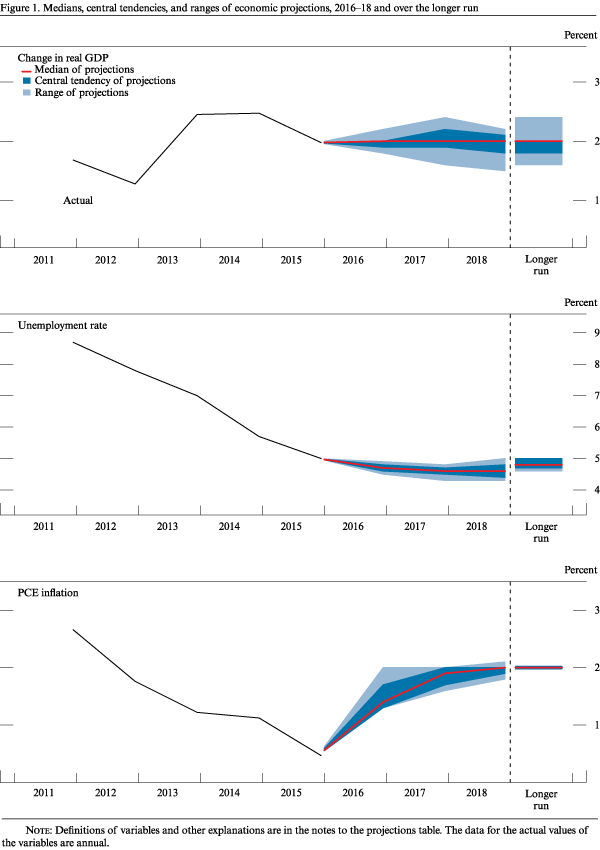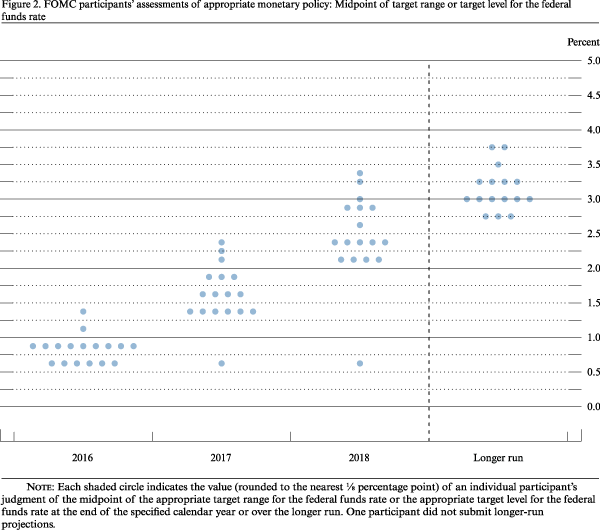- June 21, 2016: Summary
- Part 1
- Part 2
- Part 3
- Abbreviations
- Printable Version (2.74 MB PDF)

Part 3: Summary of Economic Projections
Monetary Policy Report submitted to the Congress on June 21, 2016, pursuant to section 2B of the Federal Reserve ActIn conjunction with the Federal Open Market Committee (FOMC) meeting held on June 14-15, 2016, meeting participants submitted their projections of the most likely outcomes for real output growth, the unemployment rate, inflation, and the federal funds rate for each year from 2016 to 2018 and over the longer run. 9 Each participant's projection was based on information available at the time of the meeting, together with his or her assessment of appropriate monetary policy and assumptions about the factors likely to affect economic outcomes. The longer-run projections represent each participant's assessment of the value to which each variable would be expected to converge, over time, under appropriate monetary policy and in the absence of further shocks to the economy. "Appropriate monetary policy" is defined as the future path of policy that each participant deems most likely to foster outcomes for economic activity and inflation that best satisfy his or her individual interpretation of the Federal Reserve's objectives of maximum employment and stable prices.
The median of participants' projections for the growth of real gross domestic product (GDP) was 2 percent for each year from 2016 through 2018, in line with the median estimate of the longer-run growth rate of real GDP (table 1 and figure 1). The median of growth projections in 2016 and 2017 was slightly lower than the median of near-term projections made at the time of the March FOMC meeting. The range of participants' projections for real GDP growth in 2017, 2018, and over the longer run widened somewhat relative to March.
Table 1. Economic projections of Federal Reserve Board members and Federal Reserve Bank presidents, under their individual assessments of projected appropriate monetary policy, June 2016
Percent
| Variable | Median 1 | Central tendency 2 | Range 3 | |||||||||
|---|---|---|---|---|---|---|---|---|---|---|---|---|
| 2016 | 2017 | 2018 | Longer run | 2016 | 2017 | 2018 | Longer run | 2016 | 2017 | 2018 | Longer run | |
| Change in real GDP | 2.0 | 2.0 | 2.0 | 2.0 | 1.9-2.0 | 1.9-2.2 | 1.8-2.1 | 1.8-2.0 | 1.8-2.2 | 1.6-2.4 | 1.5-2.2 | 1.6-2.4 |
| March projection | 2.2 | 2.1 | 2.0 | 2.0 | 2.1-2.3 | 2.0-2.3 | 1.8-2.1 | 1.8-2.1 | 1.9-2.5 | 1.7-2.3 | 1.8-2.3 | 1.8-2.4 |
| Unemployment rate | 4.7 | 4.6 | 4.6 | 4.8 | 4.6-4.8 | 4.5-4.7 | 4.4-4.8 | 4.7-5.0 | 4.5-4.9 | 4.3-4.8 | 4.3-5.0 | 4.6-5.0 |
| March projection | 4.7 | 4.6 | 4.5 | 4.8 | 4.6-4.8 | 4.5-4.7 | 4.5-5.0 | 4.7-5.0 | 4.5-4.9 | 4.3-4.9 | 4.3-5.0 | 4.7-5.8 |
| PCE inflation | 1.4 | 1.9 | 2.0 | 2.0 | 1.3-1.7 | 1.7-2.0 | 1.9-2.0 | 2.0 | 1.3-2.0 | 1.6-2.0 | 1.8-2.1 | 2.0 |
| March projection | 1.2 | 1.9 | 2.0 | 2.0 | 1.0-1.6 | 1.7-2.0 | 1.9-2.0 | 2.0 | 1.0-1.6 | 1.6-2.0 | 1.8-2.0 | 2.0 |
| Core PCE inflation 4 | 1.7 | 1.9 | 2.0 | 1.6-1.8 | 1.7-2.0 | 1.9-2.0 | 1.3-2.0 | 1.6-2.0 | 1.8-2.1 | |||
| March projection | 1.6 | 1.8 | 2.0 | 1.4-1.7 | 1.7-2.0 | 1.9-2.0 | 1.4-2.1 | 1.6-2.0 | 1.8-2.0 | |||
| Memo: Projected appropriate policy path | ||||||||||||
| Federal funds rate | 0.9 | 1.6 | 2.4 | 3.0 | 0.6-0.9 | 1.4-1.9 | 2.1-2.9 | 3.0-3.3 | 0.6-1.4 | 0.6-2.4 | 0.6-3.4 | 2.8-3.8 |
| March projection | 0.9 | 1.9 | 3.0 | 3.3 | 0.9-1.4 | 1.6-2.4 | 2.5-3.3 | 3.0-3.5 | 0.6-1.4 | 1.6-2.8 | 2.1-3.9 | 3.0-4.0 |
Note: Projections of change in real gross domestic product (GDP) and projections for both measures of inflation are percent changes from the fourth quarter of the previous year to the fourth quarter of the year indicated. PCE inflation and core PCE inflation are the percentage rates of change in, respectively, the price index for personal consumption expenditures (PCE) and the price index for PCE excluding food and energy. Projections for the unemployment rate are for the average civilian unemployment rate in the fourth quarter of the year indicated. Each participant's projections are based on his or her assessment of appropriate monetary policy. Longer-run projections represent each participant's assessment of the rate to which each variable would be expected to converge under appropriate monetary policy and in the absence of further shocks to the economy. The projections for the federal funds rate are the value of the midpoint of the projected appropriate target range for the federal funds rate or the projected appropriate target level for the federal funds rate at the end of the specified calendar year or over the longer run. The March projections were made in conjunction with the meeting of the Federal Open Market Committee on March 15-16, 2016. One participant did not submit longer-run projections in conjunction with the June 14-15, 2016, meeting.
1. For each period, the median is the middle projection when the projections are arranged from lowest to highest. When the number of projections is even, the median is the average of the two middle projections. Return to table
2. The central tendency excludes the three highest and three lowest projections for each variable in each year. Return to table
3. The range for a variable in a given year includes all participants' projections, from lowest to highest, for that variable in that year. Return to table
4. Longer-run projections for core PCE inflation are not collected. Return to table
The median of projections for the unemployment rate edges down from 4.7 percent at the end of 2016 to 4.6 percent in 2017 and 2018, modestly below the median assessment of the longer-run normal unemployment rate of 4.8 percent. The medians and ranges of the unemployment rate projections for 2016 to 2018 were nearly unchanged from March.
The median of projections for inflation as measured by changes in the price index for personal consumption expenditures (PCE) in 2016 stands at 1.4 percent, a bit higher than in March; the median rises to 1.9 percent for 2017 and to the Committee's objective of 2 percent for 2018 and over the longer run. The medians of projections for core PCE inflation also rise gradually over the next two years.
With regard to participants' projections of appropriate monetary policy, the median projection for the federal funds rate rises only gradually from 7/8 percent in 2016 to 1-5/8 percent at the end of 2017 and 2-3/8 percent by the end of 2018, somewhat below the 3 percent median of participants' estimates of its longer-run normal level (figure 2). Although the median federal funds rate at the end of 2016 is unchanged from the March projection, a number of participants revised down their projections. For 2017 and 2018, the median projections are 1/4 percentage point and 5/8 percentage point lower, respectively, than in March. The median estimate of the longer-run level of the federal funds rate was revised down 1/4 percentage point. These projections represent participants' individual assessments of appropriate policy consistent with their projections of economic growth, employment, inflation, and other factors. However, the economic outlook is inherently uncertain; thus, each participant's assessment of appropriate policy is also necessarily uncertain, especially at longer time horizons, and will change in response to changes to the economic outlook and associated risks.
A more complete description of the Summary of Economic Projections will be released with the minutes of the June 14-15, 2016, FOMC meeting on July 6.
Footnotes
9. One participant did not submit longer-run projections in conjunction with the June 2016 FOMC meeting. Return to text


